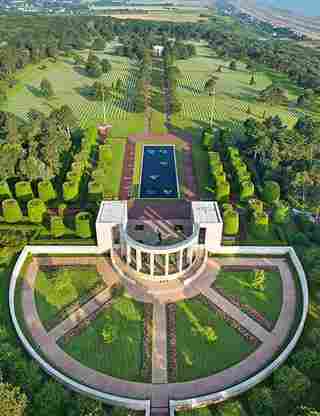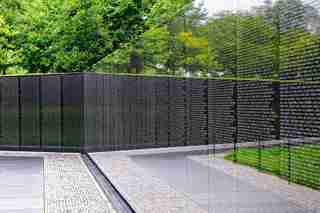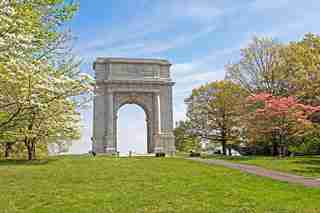Moving War Memorials to Visit Around the World
Much more than a mere long weekend, Memorial Day is an opportunity for all Americans to remember those brave individuals who died while serving in our country's armed forces. It's vitally important to think of those who paid the ultimate price just so that we can enjoy the such freedoms as fair elections, rule of law, and human rights, among many others. One way to pay our respects is by spending time at a war memorial and honoring the creed once described by President Obama , "Our nation owes a debt to its fallen heroes that we can never fully repay, but we can honor their sacrifice." Scattered throughout the country in places such wide-ranging places as Manila, Philippines and Boston, Massachusetts, the trip can also be parlayed into seeing other sites each region has to offer. As such, AD has rounded up a list of the most moving war memorials around the world for you to consider visiting over the very weekend that honors the brave men and women who have sacrificed so much.

Normandy American Cemetery, Colleville-sur-Mer, France
The cemetery serves as the final resting place for many of the American soldiers who were killed in the D-Day landings in June 1944. The memorial includes a colonnade, featuring maps and information about the operations in the area, that opens to the statue The Spirit of American Youth Rising from the Waves and a serene reflecting pool. The semicircular “Wall of the Missing” pays tribute to soldiers who could not be identified.

Vietnam Veterans Memorial, Washington, D.C.
The controversial plan for the memorial was created by artist and architect Maya Lin, who was an undergraduate at Yale at the time of the design competition. Constructed of black granite sunk into the landscape, the memorial wall chronologically lists the names of more than 58,000 service members who died or went missing during the war. Following the dedication in 1982, two statues, The Three Servicemen and *Vietnam Women’s Memorial,*were added to the site, along with a flagstaff and a memorial plaque.

National Memorial Arch at Valley Forge, King of Prussia, Pennsylvania
Designed by Paul Philippe Cret and inspired by Rome’s Arch of Titus, the National Memorial Arch commemorates the arrival of General George Washington and the Continental Army at Valley Forge, where they would camp during the 1777–78 winter. The army’s time at the site is considered a turning point in the Revolutionary War. The design initially called for two arches, one named for Washington and the other for General Friedrich Wilhelm von Steuben, but Congress only approved funding for one, which was dedicated in 1917.
World War II Valor in the Pacific Monument, Honolulu
The World War II Valor in the Pacific monument, which is spread over several sites, commemorates the American lives lost in the Pacific front in WWII, including those killed in the attack on Pearl Harbor on December 7, 1941. While the monument also has locations in California and Alaska, the majority of the sites are in Pearl Harbor, including the USS Arizona Memorial. Designed by architect Alfred Preis and accessible via boat, the memorial is positioned directly above the wreckage of the sunken battleship.
Bunker Hill Memorial, Boston
Part of Boston’s Freedom Trail, the Bunker Hill Memorial observes the first major battle of the Revolutionary War. The 221-foot-tall granite obelisk, dedicated in 1843, is located on Breed’s Hill, where most of the fighting actually took place. Visitors can climb 294 steps to the top of the tower to enjoy panoramic views of the city.
Liberty Memorial, Kansas City, Missouri
The 217-foot-tall tower, part of the National WWI Museum, was designed in the Egyptian Revival style by architect H. Van Buren Magonigle and dedicated in 1926. At the top, four-foot-high guardian spirits, carved by artist Robert Aitken, symbolize the values of honor, courage, patriotism, and sacrifice.
Virginia War Memorial, Richmond, Virginia
The stone-and-glass memorial, designed by architect S. J. Collins, is inscribed with the names of Virginians who were killed during World War II. Originally dedicated in 1956, it was renovated and expanded beginning in the 1980s to recognize residents who served in later military conflicts, including the wars in Korea, Vietnam, and the Persian Gulf, and to add an education center.
Soldiers and Sailors Memorial, Hartford, Connecticut
A symbol of the city, the Soldiers and Sailors Memorial Arch was built in tribute to Hartford citizens who fought in the Civil War and was dedicated in 1886 on the anniversary of the Battle of Antietam. The 116-foot-tall Gothic brownstone monument was designed by local architect George Keller and features terra-cotta friezes that depict scenes from the war and the arrival of peace.
Indianapolis War Memorial, Indianapolis
Architects Frank B. Walker and Harry E. Weeks of Walker and Weeks designed the imposing building, which was inspired by the Mausoleum at Halicarnassus, one of the seven wonders of the ancient world. The 210-foot-tall monument contains three floors, including the cavernous Shrine Room on the third level, which features 24 red-marble pillars, a 110-foot-high ceiling, and an illuminated Swedish-crystal star.
US Marine Corps War Memorial, Washington, D.C.
Sculptor Felix W. de Weldon based his bronze statue on an image by Associated Press photographer Joe Rosenthal of five Marines and and a Navy corpsman raising the American flag following the invasion of Iwo Jima in February 1945. The memorial was dedicated in 1954, on the 179th anniversary of the Marine Corps’ founding. The flag flies 24 hours a day, 365 days a year, at full mast.
Naval Monument at Gibraltar
Made of stone from the Rock of Gibraltar, the memorial archway commemorates the work of the U.S. Navy in the area during WWI and its cooperation with the British Royal Navy. Bronze seals of the U.S. and the Navy embellish the south side of the arch, which opens onto a path toward the harbor, nicknamed the American Steps.
Manila American Cemetery, Manila, Philippines
The graves of soldiers who were killed fighting in the Philippines and New Guinea during WWII are arranged in concentric rings around a central memorial. Designed by San Francisco architect Gardner A. Dailey, the memorial includes a limestone-clad chapel and two hemicycles that curve around the Memorial Court and display tablets listing the names of missing soldiers.
Tomb of the Unknown Soldier, Arlington, Virginia
While Arlington National Cemetery contains many military memorials, the most famous is the Tomb of the Unknown Soldier, which honors those who died without recognition. Located on the Memorial Amphitheater Plaza, a marble sarcophagus marks the grave of an unidentified soldier from World War I, while marble markers designate the graves of soldiers from WWII and Korea. The unknown soldier interned after the Vietnam war was identified in 1998, and the crypt remains empty.